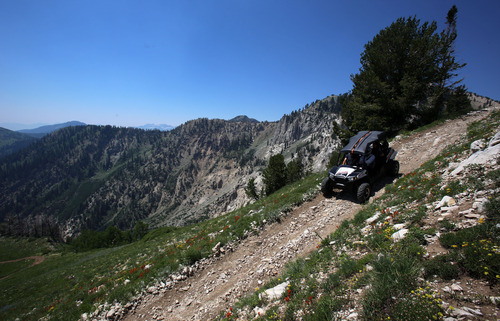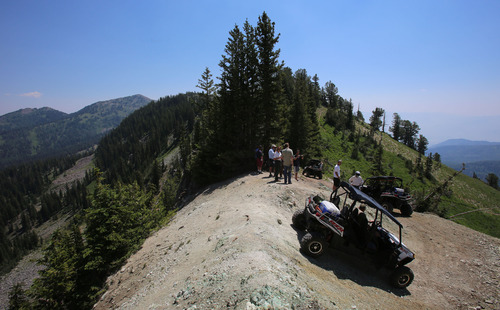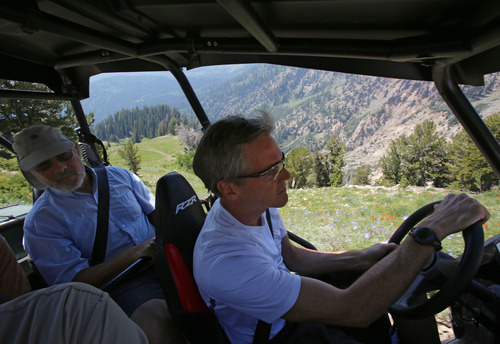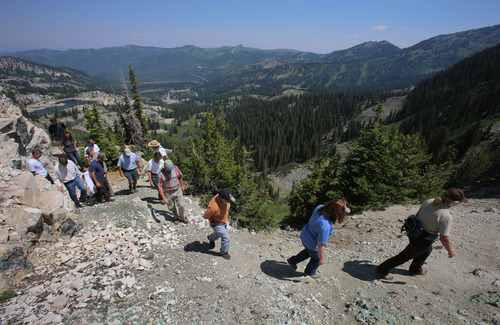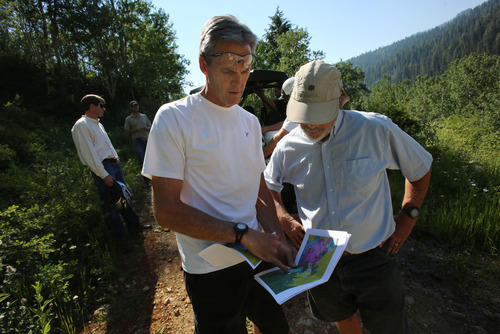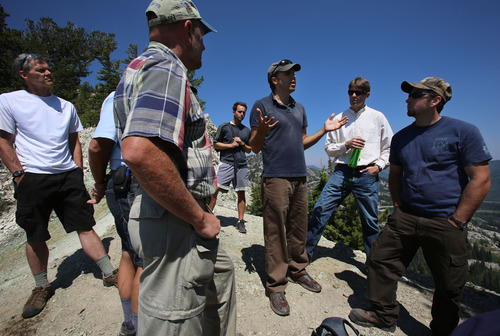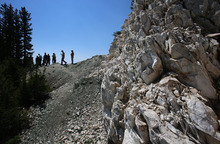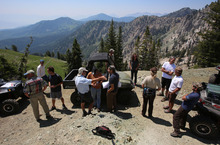This is an archived article that was published on sltrib.com in 2013, and information in the article may be outdated. It is provided only for personal research purposes and may not be reprinted.
Hoping that seeing will encourage believing, a company that has devised an innovative proposal to convert its private property in the central Wasatch Mountains into public lands took federal and state land managers to the mountaintop Wednesday to show them the lay of the land.
Great Western Mining Co., which claims ownership of 350 acres of land and another 1,500 acres of subsurface mineral rights in the high mountain country where Salt Lake, Wasatch and Utah counties come together, organized the four-wheeler tour up to a rocky ridgeline offering panoramic views of the terrain.
The goal: To clarify for Cathy Kahlow, the U.S. Forest Service's Salt Lake District ranger, and representatives of the state Department of Natural Resources what lands could come their way if the plan put together by Great Western Mining pans out.
Kahlow, for one, was more than willing to take a look.
"Who knows if this will ever happen," she said. "But it's important for me to know the process early because things might come up that we're for or against."
"It's a unique way of preserving land," added Susan Zarekarizi, lands and environmental coordinator for the state Division of Parks and Recreation. "If they can do what they want, it could be excellent."
The plan is to take a portion of the profits from renting University of Utah student housing to visitors to the summer Outdoor Retailer trade show and to donate that money, along with funds from other sources, to the Wasatch Canyons Foundation.
Directed by former Envision Utah planning leader Gabe Epperson, the nonprofit foundation would use the proceeds to purchase Great Western Mining's land and mineral rights in a phased process during the next few years.
The foundation then would transfer those lands to the appropriate land-use agencies.
"We're working out the details of who the [different] lands would be donated to," Epperson said, as well as technical details such as the need for conservation easements.
Right now, he elaborated, the idea would be to deed surface lands in Big Cottonwood Canyon over to the Forest Service, which manages most of the territory on Salt Lake County's side of the ridge.
The state seems like the best recipient for lands on the Wasatch County side of the ridge, Epperson added, since Wasatch Mountain State Park already manages most of the area in upper Snake Creek Canyon.
He asked the federal and state land managers to start calculating what it might cost to maintain these lands if they take control so the foundation can tell potential donors more precisely how their contributions will be used. "Please put together estimates so, as we raise funds, we possibly could create an endowment to help with maintenance costs," Epperson said.
Wasatch Mountain State Park Manager Bruce Strom said he was eager to learn more about the proposal, remaining neutral except to say he was not enthusiastic about an idea floated by Epperson and his colleagues to develop a series of yurts in the high-mountain country that could be used by recreationists in winter or summer.
"I'd have a hard time encouraging people to come up here in the winter," Strom said, citing widespread avalanche danger throughout the steeply sloped property, which also extends into upper Little Cottonwood Canyon and Utah County. "Summer is different. Summer is wonderful, beautiful up here."
The contingent of state officials also included P.J. Abraham, of the Utah Division of State Lands and Forestry. Like Strom, he knew little about the proposal in advance and was "interested to hear what they have in mind."
He was especially keen to evaluate the vulnerability of the area's trees to attack by beetles, which are ravaging forests on the opposite side of the Heber Valley but have not yet left their deadly mark on upper Snake Creek Canyon.
Also along for the inspection was Michael Budig of the Wasatch Mountain Club, a 92-year-old hiking and conservation group.
"I'd like to learn more about the process and see what we can do to push it along," Budig said. "There's a lot of land up here worth preserving. I hope they can pull it off."
Twitter: @sltribmikeg


